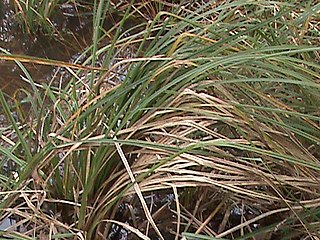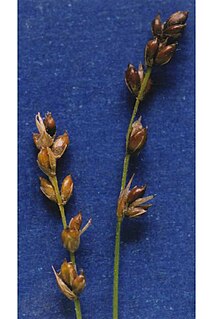
Carex atherodes is a species of sedge known by the common name wheat sedge. It is native to Eurasia and much of North America including most of Canada and the United States. It is a very common wetland plant across the American Midwest and areas west. It grows in moist and wet habitat, such as marshes and moist prairie land, and it may grow in shallow water. This sedge produces triangular, hollow stems 30 to 120 centimeters tall. The leaves are hairy, especially on the lower parts, and the leaf sheath is tinted with reddish purple. The inflorescence is up to 60 centimeters long and made up of several spikes; those spikes near the tip are usually staminate, and those lower in the inflorescence are usually pistillate. The tip of each fruit has two or more long, thin teeth.

Carex athrostachya is a species of sedge known by the common name slenderbeak sedge. It is native to western North America, including Alaska to central Canada, the western contiguous United States, and just into Baja California.

Carex barbarae is a species of sedge known as Santa Barbara sedge.

Carex comosa is a species of sedge known as longhair sedge and bristly sedge. It is native to North America, where it grows in western and eastern regions of Canada and the United States, and parts of Mexico. It grows in wet places, including meadows and many types of wetlands. Tolerates deeper water than most common species and is good for retention basins. This sedge produces clumps of triangular stems up to 100 or 120 centimeters tall from short rhizomes. The inflorescence is up to 35 centimeters long and has a long bract which is longer than the spikes. It is a cluster of several cylindrical spikes. The scales over the fruits taper into long, thin awns.

Carex diandra is a species of sedge known by the common names lesser tussock-sedge and lesser panicled sedge.

Carex disperma is a species of sedge known by the common names softleaf sedge or two-seed sedge. It is native to much of the northern Northern Hemisphere, from Alaska to Greenland, most of Canada and the contiguous United States, and across Eurasia.

Carex douglasii is a species of sedge known by the common name Douglas' sedge.

Carex hystericina is a species of sedge known by the common names bottlebrush sedge and porcupine sedge. It is native to much of North America including most of southern Canada and most of the United States. It grows in wet habitat such as wetlands and riverbanks, especially on calcareous soils. In the right conditions it can become very abundant and even weedy. This sedge produces dense or loose clumps of triangular stems up to a meter tall from short rhizomes. The inflorescence is several centimeters long and is accompanied by a bract which is longer than the spikes. The fruits are coated in perigynia with pointed, toothed tips. It is highly recommend for sedge meadow restorations.

Carex illota is a species of sedge known by the common name sheep sedge. It is native to western North America, where it grows in wet places such as marshes and mountain meadows, from New Mexico and California north to Western Canada.

Carex luzulina is a species of sedge known by the common name woodrush sedge.

Carex nigricans is a species of sedge known by the common name black alpine sedge.

Carex pellita is a species of sedge known by the common name woolly sedge.
Carex petasata is a species of sedge known by the common name Liddon sedge.

Carex praeceptorum is a species of sedge known by the common names early sedge and teacher's sedge.
Carex sheldonii is a species of sedge known by the common name Sheldon's sedge.

Carex spissa is a species of sedge known by the common name San Diego sedge. It is native to the southwestern United States in California, Arizona, and New Mexico, and far northern Mexico. It grows in wet places such as seeps and streambanks, sometimes on serpentine soils. This sedge looks somewhat like a cattail. It produces angled stems easily exceeding a meter in height surrounded by leathery green to reddish leaves up to about 1.2 meters long. The inflorescence is up to 80 centimeters long, with many long reddish brown flower spikes, each holding up to 300 developing fruits.

Carex lutea is a rare species of sedge known by the common names golden sedge and sulphur sedge. It is endemic to North Carolina, where it is known only from Pender and Onslow Counties in the Cape Fear River watershed. There are nine populations. The plant was discovered in 1991 and described to science as a new species in 1994, and it has not been thoroughly studied nor completely surveyed yet. Its rarity was obvious by 2002, however, when it was federally listed as an endangered species.

Carex concinna is a species of sedge known by the common names low northern sedge, northern elegant sedge, beauty sedge, and beautiful sedge. It is native to northern North America, where it occurs across Canada and in high elevations in the northern contiguous United States.
Carex garberi is a species of sedge known by the common names elk sedge and Garber's sedge native to North America.

Carex vaginata is a species of sedge known by the common name sheathed sedge. It has a circumboreal distribution, occurring throughout the northern latitudes of the Northern Hemisphere. It occurs in Alaska, throughout most all of Canada to Greenland and in Eurasia. In North America it occurs as far south as Minnesota and New York.
This page is based on this
Wikipedia article Text is available under the
CC BY-SA 4.0 license; additional terms may apply.
Images, videos and audio are available under their respective licenses.

















